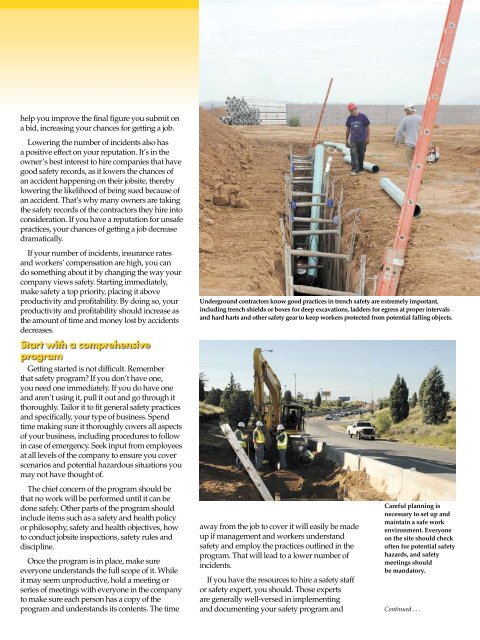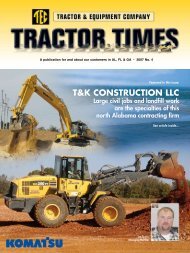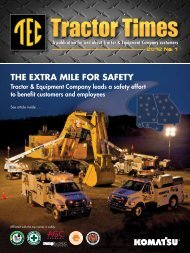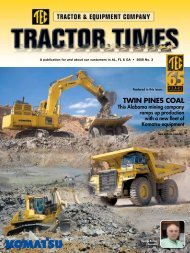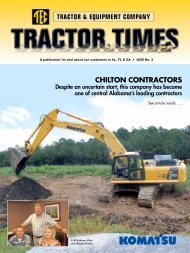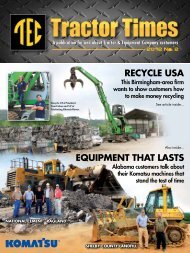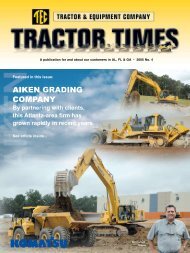EARTHWORKS GRADING & CONCRETE - TEC Tractor Times
EARTHWORKS GRADING & CONCRETE - TEC Tractor Times
EARTHWORKS GRADING & CONCRETE - TEC Tractor Times
You also want an ePaper? Increase the reach of your titles
YUMPU automatically turns print PDFs into web optimized ePapers that Google loves.
help you improve the final figure you submit on<br />
a bid, increasing your chances for getting a job.<br />
Lowering the number of incidents also has<br />
a positive effect on your reputation. It’s in the<br />
owner’s best interest to hire companies that have<br />
good safety records, as it lowers the chances of<br />
an accident happening on their jobsite, thereby<br />
lowering the likelihood of being sued because of<br />
an accident. That’s why many owners are taking<br />
the safety records of the contractors they hire into<br />
consideration. If you have a reputation for unsafe<br />
practices, your chances of getting a job decrease<br />
dramatically.<br />
If your number of incidents, insurance rates<br />
and workers’ compensation are high, you can<br />
do something about it by changing the way your<br />
company views safety. Starting immediately,<br />
make safety a top priority, placing it above<br />
productivity and profitability. By doing so, your<br />
productivity and profitability should increase as<br />
the amount of time and money lost by accidents<br />
decreases.<br />
Start with a comprehensive<br />
program<br />
Getting started is not difficult. Remember<br />
that safety program If you don’t have one,<br />
you need one immediately. If you do have one<br />
and aren’t using it, pull it out and go through it<br />
thoroughly. Tailor it to fit general safety practices<br />
and specifically, your type of business. Spend<br />
time making sure it thoroughly covers all aspects<br />
of your business, including procedures to follow<br />
in case of emergency. Seek input from employees<br />
at all levels of the company to ensure you cover<br />
scenarios and potential hazardous situations you<br />
may not have thought of.<br />
The chief concern of the program should be<br />
that no work will be performed until it can be<br />
done safely. Other parts of the program should<br />
include items such as a safety and health policy<br />
or philosophy, safety and health objectives, how<br />
to conduct jobsite inspections, safety rules and<br />
discipline.<br />
Once the program is in place, make sure<br />
everyone understands the full scope of it. While<br />
it may seem unproductive, hold a meeting or<br />
series of meetings with everyone in the company<br />
to make sure each person has a copy of the<br />
program and understands its contents. The time<br />
Underground contractors know good practices in trench safety are extremely important,<br />
including trench shields or boxes for deep excavations, ladders for egress at proper intervals<br />
and hard harts and other safety gear to keep workers protected from potential falling objects.<br />
away from the job to cover it will easily be made<br />
up if management and workers understand<br />
safety and employ the practices outlined in the<br />
program. That will lead to a lower number of<br />
incidents.<br />
Careful planning is<br />
necessary to set up and<br />
maintain a safe work<br />
environment. Everyone<br />
on the site should check<br />
often for potential safety<br />
hazards, and safety<br />
meetings should<br />
be mandatory.<br />
If you have the resources to hire a safety staff<br />
or safety expert, you should. Those experts<br />
are generally well-versed in implementing<br />
and documenting your safety program and Continued . . .


